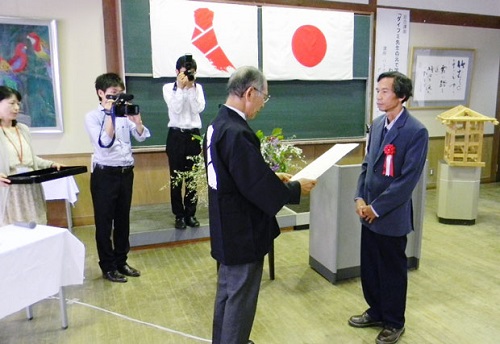Artist awarded DAIFUMI International Award
Artist Nguyen Thuong Hy, a former division chief of the Quang Nam Centre for Relic and Tourist Attraction Management, has become the first person in Viet Nam to win Japan’s DAIFUMI International Award. The award is in recognition of painter Hy’s significant contributions to the research and preservation of wooden architectural works in the central region, as well as his involvement in the restoration of Quang Nam Province’s My Son Sanctuary over recent years.
Mr Hy was born into a feudal mandarin family under the Nguyen dynasty. After his graduation from the Hue University of Fine Arts in 1979, he worked for the Museum of Quang Nam. Then, he and an architect, Kazic from Poland, researched the Champa-style architecture and ancient urban works at My Son Sanctuary and in Hoi An City between 1979 and 1994. In 1995, he attended a 6-month training course on restoring ancient architecture at Japan’s Showa University. The course was taught by Mr Fumio Tanaka, a revered Japanese carpenter after whom the award was named.
 |
| Mr Hy (right) receiving Japan’s DAIFUMI International Award |
When Quang Nam-Da Nang Province was officially divided into the two administrative divisions of Quang Nam Province and Da Nang in 1997, Hy decided to stay and work in Quang Nam Province. During his near 20-year stay there, he made significant contributions to the research, preservation, and restoration of wooden architectural works. In addition, he made proposals for recognising as national historical and cultural relics a number of ancient houses, temples and pagodas, all between 300 and 400 years old.
After retiring several years ago, Hy decided to build himself a mud-walled thatched house in the province’s My Son Village, an eco-homestay area for visitors. All his home furniture, such as tables, chairs and a bed, are made of bamboo to create an environmentally friendly atmosphere.
Presented by the Toyama International College of Crafts and Arts in Japan, the annual DAIFUMI International Award aims to recognise the significant contributions made by individuals and organisations in the preservation and restoration of ancient architectural works worldwide, especially wooden ones.
Apart from Hy, a team and two individuals, all from Japan, also won this year’s award for their achievements in preserving timber structures.